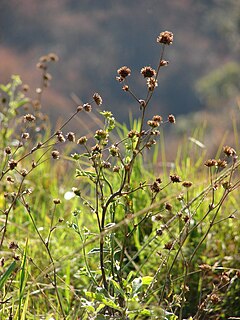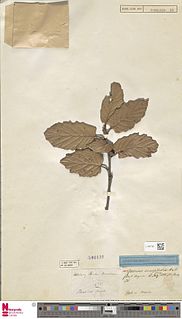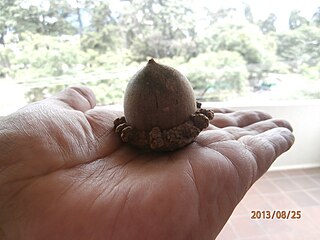
Fouquieria splendens is a plant indigenous to the Sonoran Desert and Chihuahuan Desert in the Southwestern United States, and northern Mexico.

Prunus serotina, commonly called black cherry, wild black cherry, rum cherry, or mountain black cherry, is a deciduous tree or shrub of the genus Prunus. Despite being called black cherry, it is not very closely related to the commonly cultivated cherries such as sweet cherry, sour cherry and Japanese flowering cherries which belong to Prunus subg. Cerasus. Instead, P. serotina belongs to Prunus subg. Padus, a subgenus also including Eurasian bird cherry and chokecherry. The species is widespread and common in North America and South America.

Arbutus xalapensis, commonly known as the Texas madrone, naked Indian tree or Texas madroño, is a species of flowering plant in the heather family. It is native to Central America, the southwestern United States, and throughout Mexico. It is found in canyons and mountains, on rocky plains, and in oak woodlands, at altitudes of up to 3,000 m in the south of the range, but lower, down to 600 m in the north of the range.

Quercus rugosa, commonly known as the netleaf oak, is a broad-leaved tree in the beech and oak family Fagaceae. It is native to southern North America.

Quercus glaucoides is an oak species in the white oak section, Quercus section Quercus, found in and endemic to eastern, central and southern Mexico.

Celtis ehrenbergiana, called the desert hackberry or spiny hackberry, is a plant species that has long been called C. pallida by many authors, including in the "Flora of North America" database. It is native to Arizona, Florida, New Mexico and Texas, and to Latin America as far south as central Argentina. It grows in dry locations such as deserts, brushlands, canyons, mesas and grasslands.

Ardisia escallonioides, the Island marlberry, is a plant species native to the West Indies and neighboring areas. It has been reported from Barbados, Bermuda, the Dominican Republic, Cuba, Mexico, Belize, Guatemala and Florida.

Bletia purpurea, common name pine-pink or sharp-petaled bletia, is a species of orchid widespread across much of Latin America and the West Indies, and also found in Florida. They are terrestrial in swamps or sometimes found growing on logs or stumps above the high tide mark.
Iresine heterophylla, or Standley's bloodleaf, is a plant species native to the southwestern United States and also to Mexico. It has been collected from Arizona, New Mexico, Texas, Chihuahua, Sonora, Durango, Coahuila, Nuevo León, Campeche and Tabasco.
Diastatea is a genus of plants native to Latin America, mostly in Mexico and Central America but with one species extending southward along the Andes to Argentina.
- Diastatea costaricensisMcVaugh - Guatemala, Honduras, Nicaragua, Costa Rica
- Diastatea expansaMcVaugh - central Mexico
- Diastatea ghiesbreghtii(Kuntze) E.Wimm - southwestern Mexico
- Diastatea micrantha(Kunth) McVaugh - widespread from central Mexico to the Jujuy region of northern Argentina
- Diastatea tenera(A.Gray) McVaugh - southern Mexico and Guatemala
- Diastatea virgataScheidw. - southern Mexico

Elephantopus mollis, common names tobacco weed, and soft elephantsfoot, is a tropical species of flowering plant in the sunflower family.
Bursera grandifolia is a Mexican species of trees in the frankincense family in the soapwood order. It is widespread across much of Mexico from Sonora to the Yucatán Peninsula, and found also in Central America as far south as Costa Rica.
Bursera lancifolia is a Mexican species of trees in the frankincense family in the soapwood order. It is widespread in western Mexico from Sonora to Oaxaca.

Bursera penicillata is a Mexican species of trees in the frankincense family in the soapwood order. It is widespread in much of Mexico from Sonora and Chihuahua to Oaxaca and Veracruz.

Quercus crassifolia is a Mexican species of oaks in the beech family. It is widespread from Sonora and Chihuahua to Veracruz and Chiapas. It has also been found in Guatemala.

Quercus peduncularis is an oak in the white oak group native to Mexico and Central America, ranging from Jalisco to Honduras.
Quercus candicans is a Mesoamerican species of oak tree in the beech family. It is native to central and southern Mexico and Guatemala. It grows from 1,200 to 2,700 m of altitude in wet montane forests, preferring calcareous soils.
Quercus scytophylla is a Mexican species of trees in the beech family. It is native to western and central Mexico from Sonora and Chihuahua to Chiapas.
Quercus urbanii is a Mexican species of trees in the beech family. It is native to western and central Mexico from Sinaloa, Durango, and Zacatecas to Oaxaca.

Quercus oocarpa is a Mesoamerican species of oak. It is native to Central America and eastern Mexico, with an isolated population in canyons of Jalisco in western Mexico.













